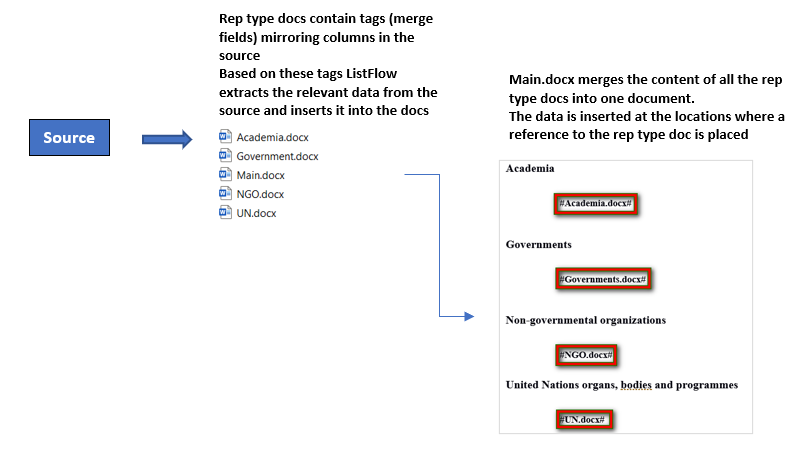Listflow is an independant tool of Indico.UN platform, empowering users with customisation of their list of participants.
Using an excel extract of your event’s participants, ListFlow generates your list of participants.
Concept
If you have ever used mail merge in MS Word, then you will certainly understand the principle of ListFlow.

ListFlow is an application designed to marry data on participants (extracted from Indico as an xls data source) with a Word template thus generating a list of participants for your event.
There are 3 easy steps:
- Template selection
- Data source selection
- LoP creation
Requirements and Installation
The requirements for ListFlow are:
- Microsoft .NET Framework 4.8 Runtime Download by microsoft.com
- Microsoft 365 (Excel and Word)
ListFlow does not require installation or special rights to install. Download the archive at the top of this page, and extract it to the desired location on your PC.
It is recommended to also create a shortcut and pin it to your Taskbar.
![]()
To run ListFlow launch ListFlow.exe and follow the instructions.
File Structure Explained
Once ListFlow has been installed, you should create a file structure similar to the below example. Click HERE to learn more about creating a Templates folder and templates for your LoPs.
- ListFlow: contains the .exe file for the application
- Templates: a folder designed to contain one or more sub-folders. Each type of LoP you have, you should have a corresponding sub-folder named accordingly. (A separate guide exists detailing how to create your own templates).

Sub-Folders
Sub-folders are specific to one type of LoP and named accordingly e.g. LoP Final.
They contain a series of docs each of which is specific to a rep type for display in the LoP and named accordingly e.g. UN.docx.
For example, for a final list of participants containing the rep types Academia, Government, NGO and UN: then in the Templates folder, there will be a sub-folder named “LoP Final” into which there are separate docs for each of the of the rep types needed for the LoP.

Rep Type Docs
Each rep type doc contains a tag made up of a selection of merge fields. The merge fields used should mirror exactly column headers that exist in the data source being used. The tag (and its merge fields) determine the data displayed on participants in the LoP. Tags may differ from one rep type doc to another depending on the type of information to be displayed in the LoP on the different types of participants.
For example, for government participants, in Government.docx you may have a tag:
«Title» «First_Name» «Last_Name», «Job_Title», «Reptype_Qualifier», «Work_City»
Whereas for UN participants, in UN.docx you may have a tag:
«Title» «First_Name» «Last_Name», «Job_Title», «Work_City»
Main.docx
Each sub-folder for a particular type of LoP MUST contain, in addition to individual rep type docs, a doc named Main.docx. This is the layout design and format that the LoP will be printed in.
In Main.docx a reference displays at locations where the corresponding participants will display in the final document.
Actual ListFlow Process
- A type of LoP is selected
- A data source is married to the LoP
- Tags in each of the rep type docs pull and insert corresponding data from the data source.
- In turn, references in Main.docx are directed to the corresponding rep type doc and copies over the data and inserts it in the location of the reference.
